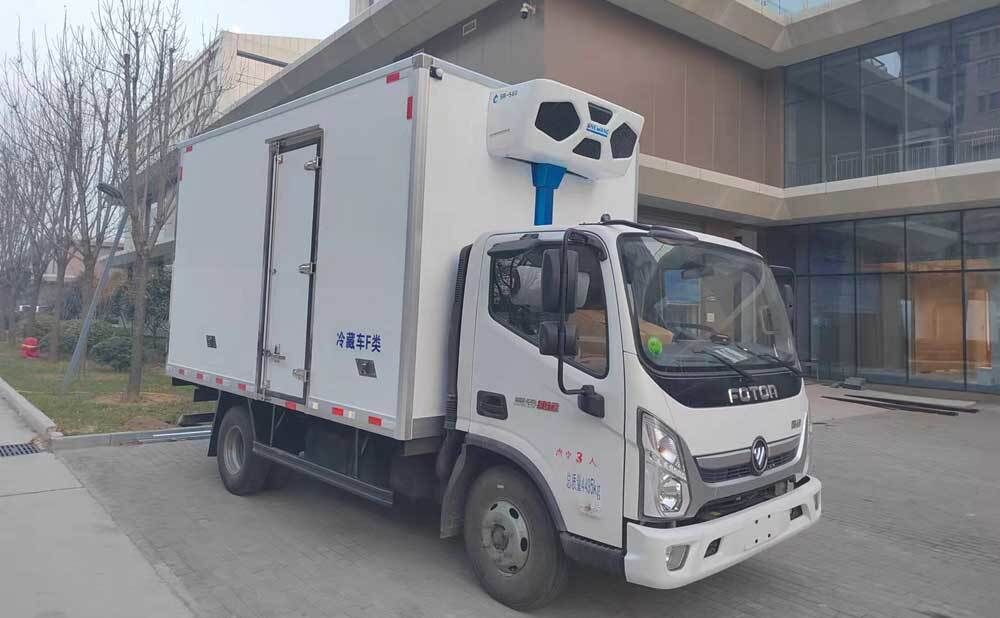One thing most consumers don’t think about when they’re enjoying this frozen sweet treat is transporting ice cream. Learn how to transport ice cream. Understand how the cold supply chain works to get everyone’s favorite frozen dessert in supermarket coolers and into your freezer.
A quick trip to your favorite ice cream shop can help you cool off from the inside out. But have you thought about how the ice cream gets from the factory to the freezer? In many cases, ice cream is transported over long distances in refrigerated trucks. The cold chain gives you a consistent and reliable way to transport perishable items like ice cream from place to place. The cold transportation process can take days, so the cold chain and cold storage is essential.
Without the cold supply chain, you’d be without some of your favorite sweet treats. Some of your favorite brands of ice cream have to travel hundreds of miles to get to your local supermarket or ice cream shop. Did you know that:
- Ben and Jerry’s ice cream comes from Wellbury, VT
- Blue Bunny ice cream comes from Le Mars, IA
- Breyers ice cream comes from Englewood Cliffs, NJ
- Haagen-Dazs ice cream comes from Minneapolis, MN
- Blue Bell ice cream comes from Brenham, TX
- Turkey Hill ice cream comes from Lancaster County, PA
- Good Humor ice cream is from Youngstown, OH
- Dreyer’s/Edy’s ice cream comes from Oakland, CA
Think about where you are in relation to where your favorite ice cream comes from. How many miles does it have to travel to get to you? This distance is why the cold supply chain is essential.

Transporting Ice Cream Long Distances: Cold Chain
The most important part of transporting ice cream is making sure it stays fresh. Ice cream can change in body, texture and flavor if it melts during shipping.
When ice cream is transported over long distances, shippers rely on the cold chain. The cold chain refers to the process of shipping and storing refrigerated and frozen goods, like ice cream. The cold chain is a series of events related to production, storage, distribution and logistics, all in a low-temperature range.
Cold chain logistics refers to all the methods used to make sure ice cream and other perishables stay a consistent temperature during the logistics process. Some experts consider cold chain logistics a technology, a science and a process. The technology part comes from the cold chain’s reliance on physical ways of maintaining low temperatures. The science part relates to the biological and chemical methods related to food storage and stability. The process part refers to the logistics methods used to maintain the supply chain. The cold chain must never be broken to keep ice cream from melting or reaching room temperature. This can destroy the quality and safety of the product.
Steps in the cold chain for transporting ice cream might include:
- Supply: The ice cream is made and packaged in a plant.
- Transport: Ice cream is generally transported in a refrigerated truck. These trucks, often called reefers, undergo routine inspections to ensure they are in tip-top condition.
- Storage: Ice cream might go into cold storage before it is distributed. Refrigerated warehouses can act as a middle ground. Warehouses can sell food to grocers. After the item is purchased, the product might enter the cold chain again for distribution and transportation to the final destination.
- Market: In most cases, the final step in the cold chain is delivery to the grocery store or venue where consumers purchase ice cream. The cold chain might continue at the supermarket. Here the ice cream might be stored in a walk-in freezer for a little while before it makes its way into the frozen display case for your to purchase.
One of the most important links in the cold chain is refrigerated trucks. Sometimes call reefer trucks, refrigerated trucks are temperature controlled vehicles designed to keep cold products cold. Unlike shipping products on ice, reefer trucks maintain a cold temperature and allow products to stay frozen. Reefer trucks can maintain temperatures ranging from 55 degrees to -20 degrees Fahrenheit. This allows them to carry a wide range of cool products. Fresh produce, cut flowers, medicine, vaccines and ice cream are all examples of products carried on refrigerated trucks. Penguins and honeybees have even been shipped on reefer trucks.
Reefer trucks are designed to log serious time on the road. A well-maintained refrigerated truck might log more than a million miles before it is retired. You might be lucky to get 200,000 miles out of your car!
The cold chain is big business. You’ll find more than 500,000 reefer trucks on the road today. Each truck likely cost at least $60,000. Refrigerated trucks are a big investment for transportation companies.
You’ll find that refrigerated trailers are designed to work independently of the tractors that haul them. Cold trailers have their own power source and refrigeration units. This means that the trailers will stay cool regardless of whether they’re being pulled by a truck or are on a train, plane or boat. Refrigerated trailers have three main components that work together to keep the contents cool: a compressor, condenser and evaporator.
The compressor is powered by a small engine unit within the refrigerated trailer. The compressor draws in a refrigerant gar and compresses it. The pressure liquefies the gas. At this point, the refrigerant is heated by the pressure.
The condenser gets the liquid refrigerant from the compressor. Heat from the liquid is exchanged in the condenser. The heat from the liquid is cooled by flowing through tubing to outside attached fins. The fins’ wide surface area allows the liquid refrigerant to cool quickly. The process is similar to how your car’s radiator cools the engine.
The evaporator is inside the trailer. By the time the refrigerant reaches the evaporator, it has given up most of its heat and is now a cool liquid. Refrigerant flows into the evaporator through a throttle-like valve. When in the evaporator, the refrigerant expands into a gaseous form. As it goes through the evaporator, heat is absorbed through finned coils. The trailer’s temperature drops by giving heat to the evaporator for the refrigerant to cool. This process happens over and over until the trailer reaches the desired temperature.
Even though technology is important to the cold chain, it isn’t a new concept. The cold chain was invented in 1842. Back them, railroad cars were used to ship cold products on ice in cold weather. Straw was used as insulation. The first cold truck was used in 1910 and it moved cold products on ice. Refrigerated trucks were first seen on the road in the 1940s. These trucks with roof-mounted cooling, invented by refrigeration expert Frederick McKinley Jones, paved the way for today’s high-tech reefer trucks. Over the past 170-plus years, cold transport has changed significantly thanks to technology and advances in engineering.
SNEWANG Transportation specializes in moving highly perishable items, like ice cream. Refrigerated trucks have become technologically advanced since the days when perishable items were shipped on blocks of ice. Refrigerated trucks are equipped with a sophisticated cooling system to keep products at a safe temperature. Additionally, many reefer trucks are equipped with more than 1,000 pounds of foam for insulation to maintain a consistent temperature.

You Scream, I Scream, We All Scream for Ice Cream
Americans love their ice cream. According to the International Dairy Foods Association, the top 10 ice cream flavors in the U.S. are:
- Neapolitan
- Moose Tracks
- Strawberry
- Cookie Dough
- Butter Pecan
- Chocolate Chip Cookie Dough
- Mint Chocolate Chip
- Cookies and Cream
- Chocolate
- Vanilla
Today’s foodie culture means that gourmet ice cream is a favorite treat for many consumers. In addition to the top brands you’ll find in your favorite local supermarket, many consumers are choosing to have gourmet and boutique ice cream shipped to their door. These smaller ice cream brands might follow their own kind of cold chain when shipping out their product. Thanks to technology and dry ice, mail order boutique ice cream is a growing business for many smaller brands.
Some small ice cream brands like Jeni’s Splendid Ice Creams will ship their gourmet right to your door. This gives you access to flavors you might not find at your supermarket. Brambleberry Crisp, Brown Butter with Almond Brittle, Speculoos Cookie Butter and other gourmet flavors can be purchased online and delivered straight to your home. These gourmet companies transport their fancy ice cream via U.S. Mail or shipping services like UPS. Shipping charges can be steep, but ice cream needs to travel quickly. Because they are smaller markets, they might bypass the traditional cold chain.
These smaller, boutique ice creams often ship their products directly to consumers in a cooler on dry ice. Dry ice is a solid form of carbon dioxide. It can stay colder longer than regular ice made with water. One thing that makes dry ice unique is that it doesn’t melt. It goes straight from frozen solid form the a gas. The scientific name for the process of dry ice turning into gas is sublimation.
When kept in a cooler, like one that might be used to transport ice cream, dry ice can last up to 24 hours. This is why it is important for ice cream to travel quickly. Twenty-four hour shipping and the coolers needed to ship gourmet ice cream can make delivery expensive. When buying gourmet ice cream, you might spend more on shipping than the ice cream itself.
In addition to its applications shipping frozen food like ice cream, dry ice can be used in industrial and scientific settings, too. You need to be careful around dry ice. Exposing your bare skin to dry ice can quickly result in frostbite and other complications.
Best Way to Transport Ice Cream
The best way to transport ice cream depends on how much ice cream you need to transport. If you are shipping large quantities of the sweet stuff to supermarkets or stores, you might rely on the cold chain to get it there. Small quantities of ice cream sent directly to consumers can be shipped via mail on dry ice.
The cold chain might be the best way to transport ice cream. This transport method is a demanding logistics process. The cold chain doesn’t just transport frozen items from around the U.S., it can be used to transport cold items around the world. As the cold chain becomes global, shipping and transport companies are finding creative ways to keep items icy and cool.
A challenge facing the cold chain industry is the food industry’s increased focus on quality. To keep the integrity of cold chain products like ice cream, temperature must be maintained. Changes in texture and taste can occur when ice cream and other products stray from the recommended temperature ranges.
The cold chain can involve intermodal shipping. Intermodal shipping involves more than one kind of transportation. Intermodal means your cold cargo might travel by truck, train, plane or ship — or any combination of these methods. Generally intermodal shipping uses special containers. These containers can be transferred from rail to truck without being repacked.
The best way to transport ice cream depends on how much ice cream you are shipping and its final destination. Intermodal shipping can help you get your product from coast to coast or around the world. The cold chain is a logistics process that makes the transport of ice cream possible.
Transporting Ice Cream Novelties
Americans love ice cream novelties almost as much as they love a scoop of the frozen sweet stuff. According to information from the International Dairy Foods Association, the most popular ice cream novelties are:
- Sandwiches
- Mini cups
- Sticks or pops
- Cones
- Bars
Ice cream novelties have the same shipping process as regular ice cream. The cold chain will help keep your ice cream novelties frozen and stable during shipping for long distances. Some favorite ice cream novelty brands and their places of origin include:
- Good Humor ice cream novelties come from Youngstown, OH
- Klondike Bars are made by Good Humor and come from Youngstown, OH
- Blue Ribbon ice cream bars and novelties are made by Blue Bunny and come from Le Mars, IA
- Popsicle frozen treats are originally from California
Thinking about where your favorite frozen treat comes from can make it easy to understand why the cold chain is important.
Transporting Soft Serve Ice Cream
Soft service ice cream is a little different than regular frozen ice cream. Soft serve gets its smooth, creamy whipped texture from air that is introduced into the ice cream. Next, the ice cream is churned to add air. Soft serve ice cream is often made on site at the location where it is served. Soft serve is made using a premix, which is often shipped to the location where the ice cream is made and sold. The three types of soft serve premix include:
- Fresh liquid mix: This creamy liquid is produced in a factory and shipped via the cold chain to its final destination. It require constant refrigeration until it is used. Handlers must be very careful that the liquid mix stays cold until use. Should the mix reach room temperature, it will spoil and bacterial contamination will occur.
- Powdered mix: Powdered soft serve ice cream mix is shelf stable. It might still be shipped with the cold chain, as it must remain at or below room temperature to prevent bacterial contamination. You must add water to powdered soft serve mix before it is frozen and churned.
- Ultra heat-treated mix: Ultra heat-treated mix is the newest soft serve option and is considered the safest against bacteria. It can be stored for a long time and doesn’t require the cold chain for shipping. Water must be added to this mix before it is churned, frozen and served.
The way you transport soft serve ice cream premix depends on what formula you choose. You might need to use the cold chain to make sure your soft serve mix is delivered safely.
Fast Facts About Ice Cream
Now that you know a little more about how to transport ice cream, it is time for some fun facts. The International Dairy Foods Association has compiled many facts about the frozen sweet stuff, many of which are of interest to retailers and consumers alike:
- Retailers report that premium ice cream is most popular with their consumers, while ice cream manufacturers report that regular ice cream, the kinds usually sold in supermarkets, are most popular with consumers.
- Strawberry is the most popular fruit flavor for ice cream.
- Are you a pistachio ice cream fan? You might be in the minority. Pecan is the most popular nut flavor according to the International Dairy Foods Association.
- Love ice cream with a little pizzazz? Chocolate and candy are the most popular mix-ins for confectionery ice cream.
- Do you like your ice cream in a cone or a cup? Sugar cones and waffle cones are tied for the most popular container for ice cream.
- Time of year matters when it comes to ice cream. The summer months of June and July are the busiest months for ice cream production and transportation.
- Ice cream is big business. It contributes $39 billion to the U.S. economy and creates nearly 200,000 jobs across the country.
- Many ice cream companies are family-owned businesses and have been around for more than 50 years. SNEWANG Transportation is a family owned company, so we have that in common with the ice cream we are equipped to haul in our reefer trucks!
- Hard frozen dairy desserts, like regular ice cream, made up close to 75 percent of all of the frozen dairy products made in 2015.
- The Midwest loves the sweet stuff. Illinois, Indiana, Michigan, Ohio and Wisconsin are the top consumers of ice cream according to manufacturers and retailers.
- In today’s health-conscious world, low-fat ice cream is the second most popular and best-selling category of ice cream.
- Families are the primary consumers for ice cream retailers
- Ice cream marketing is usually done at a regional or local level
As you can surmise from the facts above, ice cream is big business. The transport of ice cream is part of this growing enterprise. Cold chain logistics makes the ice cream business possible.

How to Transport Ice Cream and Get Down to Business
Ice cream is more than just a sweet treat. It is big business for everyone involved. From production the the cold chain, transporting ice cream is serious business. Knowing how to transport ice cream can help your business grow.
SNEWANG Transportation is a family-owned refrigerated trucking company that help you work the cold chain to your best advantage. Make SNEWANG your premium choice in refrigerated transportation. You’ll find that SNEWANG is one of the top companies in the transportation industry because we care about our clients and we care about our drivers. By giving our clients high-quality service with top-of-the-line equipment, we can promise you that your freight will be delivered in top quality in a timely manner without complications.




